You are here
Analysis of the President’s Fiscal Year 2014 Budget
INTRODUCTION
The President's Budget for Fiscal Year 2014 projects that the federal budget deficit will gradually decline under the President's policies from 7.0 percent of gross domestic product (GDP) in 2012 to 1.7 percent in 2023. However, this projection provides little comfort. Federal debt would rise to 78 percent of GDP in 2014 — higher than it has been at any point in our history since 1950. It would then decline to 73 percent of GDP by 2023, which would still substantially exceed its historical average of 38 percent of GDP for the past 50 years.
More worrisome is the fact that the budget does not project that the debt will fall significantly as the economy recovers. Instead, debt would remain high at a time when large numbers of baby boomers will be retiring, becoming eligible for Social Security and Medicare and placing new demands on those programs. Combined with the continued growth of health costs, entitlement spending is expected to surge in the decade after 2023 while revenues are expected to remain flat, driving long-term deficits and debt upward.
The President's budget includes some policies that would begin to address the fundamental drivers of our long-term deficits, but its proposals are too modest to put the budget on a plausible and sustainable path for the long run.
Now that the President, House, and Senate have each proposed their own budgets for 2014, it is in our nation's best interest for our leaders to adopt a budget that addresses our long-term structural deficits. The long-run challenges facing the United States are daunting, and substantial changes in both spending and revenues will be needed to put the budget on a sustainable track. Credible, bipartisan solutions exist that could be implemented gradually when the economy is stronger. The sooner we commit to such a plan, the better.
The President's fiscal year 2014 budget
|
2012 (Actual) |
2013 | 2014 | 2023 |
10-year total: 2014-2023 |
|
|---|---|---|---|---|---|
|
Billions of dollars
|
|||||
|
Revenues
|
$2,450 | $2,712 | $3,034 | $5,220 | $41,231 |
|
Outlays
|
|||||
|
Discretionary
|
$1,285 | $1,258 | $1,242 | $1,278 | $12,451 |
|
Mandatory
|
$2,032 | $2,203 | $2,308 | $3,609 | $29,059 |
|
Net Interest
|
$220 | $223 | $223 | $763 | $4,905 |
|
Total
|
$3,537 | $3,685 | $3,778 | $5,660 | $46,502 |
|
Deficit
|
$1,087 | $973 | $744 | $439 | $5,271 |
| Debt held by the public | $11,281 | $12,404 | $13,296 | $19,030 | N/A |
|
Percent of GDP
|
|||||
|
Revenues
|
15.8 | 16.7 | 17.8 | 20.0 | 19.1 |
|
Outlays
|
|||||
|
Discretionary
|
8.3 | 7.8 | 7.3 | 4.9 | 5.9 |
|
Mandatory
|
13.1 | 13.6 | 13.6 | 13.9 | 13.5 |
|
Net Interest
|
1.4 | 1.4 | 1.3 | 2.9 | 2.2 |
|
Total
|
22.8 | 22.7 | 22.2 | 21.7 | 21.6 |
|
Deficit
|
7.0 | 6.0 | 4.4 | 1.7 | 2.5 |
|
Debt held by the public
|
72.6 | 76.6 | 78.2 | 73.0 | N/A |
SOURCE: Data from the Office of Management and Budget, Fiscal Year 2014 Budget of the U.S. Government, April 2013. Compiled by PGPF.
Economic Assumptions
The Administration projects a slow and gradual economic recovery. According to the budget, the unemployment rate will remain above six percent until 2017 — almost a decade after the recession began in 2007. These projections are consistent with historical evidence showing that after a financial crisis, economies recover very slowly. The Congressional Budget Office (CBO) presented a similarly pessimistic forecast in its latest report.
The administration’s economic forecast also highlights the retirement of the baby boom generation, a major development in our economy in coming years. As baby boomers leave the workforce over the next two decades, the growth of the labor force will slow, which will dampen economic growth. Thus, even after the economy recovers the administration projects that economic growth will be slower than its historical average since World War II. While real economic growth averaged 3.2 percent per year since 1947, the budget projects an annual growth rate of 2.3 percent by the end of the decade.
Comparing the President's Budget to the House and Senate Budgets
Although the President's budget was due in early February, by the time of its release this year in April the House and Senate had already debated and adopted budgets of their own. Within the limited scope of the ten-year projection window, each of the three budget plans would stabilize and decrease debt as a share of GDP compared to this year’s level of 76 percent. The President’s budget would produce the highest level of debt at 73 percent of GDP in 2023. Debt under the Senate budget would reach 70 percent of GDP in 2023 and debt under the House budget would drop to 55 percent of GDP.
Federal debt under current budget plans
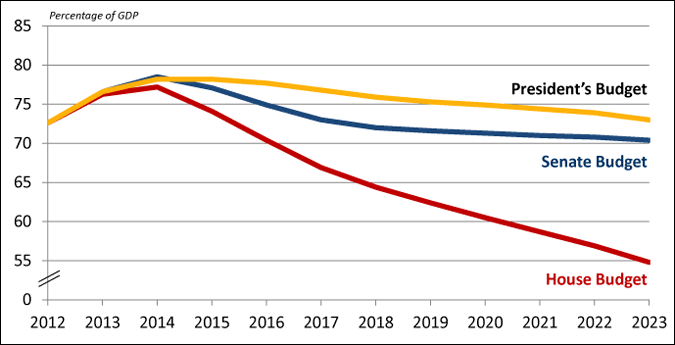
SOURCE: Data from the House Budget Committee, The Path to Prosperity: A Responsible, Balanced Budget, March 2013; Senate Budget Committee, Foundation for Growth: Restoring the Promise of American Opportunity, March 2013; and the Congressional Budget Office, The Budget and Economic Outlook: Fiscal Years 2013 to 2023, February 2013; Office of Management and Budget, Fiscal Year 2014 Budget of the U.S. Government, April 2013. Federal debt is debt held by the public. Compiled by PGPF.
The House budget would cut spending quickly, bringing deficits below one percent of GDP by 2015 and balancing the budget by the end of the decade. That deficit reduction plan would rely entirely on spending cuts, with nearly half of the cuts coming from health care programs, including the repeal of the 2010 health care reform law. It would cap the growth of Medicaid spending and make reductions in other programs. It also proposes a major reform for Medicare, but that reform wouldn't produce significant budgetary savings until after 2023.
Health spending under current budget plans
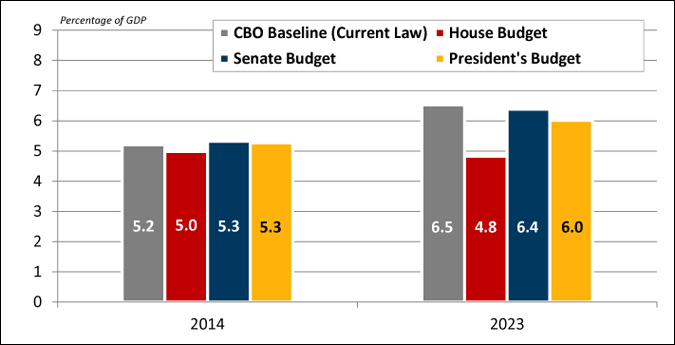
SOURCE: Data from the House Budget Committee, Concurrent Resolution on the Budget — Fiscal Year 2014, House Report 113-17, March 2013; Senate Budget Committee, Concurrent Resolution on the Budget FY 2014, Senate Report 113-12, March 2013; Office of Management and Budget, Fiscal Year 2014 Budget of the U.S. Government, April 2013. Compiled by PGPF.
NOTE: Health spending is measured by mandatory spending for the budget functions 550 and 570.
The Senate budget proposes more modest deficit reduction composed of both spending cuts and tax increases, and it puts the debt on a downward path by the end of the decade. Senate Democrats also propose $100 billion in additional stimulus spending in the short term, which increases deficits in 2013 and 2014. The cumulative effect of higher taxes and reduced defense spending lowers deficits in later years.
Deficits under current budget plans
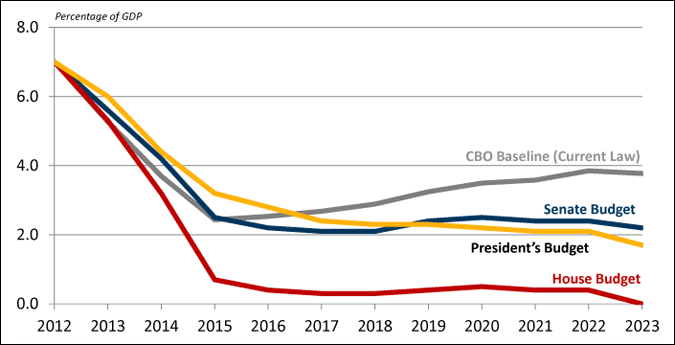
SOURCE: Data from the House Budget Committee, Concurrent Resolution on the Budget — Fiscal Year 2014, House Report 113-17, March 2013; Senate Budget Committee, Concurrent Resolution on the Budget FY 2014, Senate Report 113-12, March 2013; Office of Management and Budget, Fiscal Year 2014 Budget of the U.S. Government, April 2013. Compiled by PGPF.
The budget proposed by the President is similar to that of the Senate, and contains both revenue increases and substantial spending cuts. Over the next ten years, the President plans to reduce discretionary spending by $202 billion below the cumulative total allowed under the Budget Control Act of 2011 (BCA). However, the President would wait to implement some of the cuts until 2017 after the economy has had more time to recover. In the near term, the President, like the Senate, proposes additional fiscal stimulus. The President’s budget would also raise about the same amount of total revenue as the Senate’s budget over the next decade, but would bring in less revenue over the first five years and more over the last five. This would contribute to higher deficits from 2014 to 2018 when compared to those under the Senate’s budget.
Comparison of fiscal year 2014 budget plans
Percentage of GDP
|
2012
|
2023
|
||||
|---|---|---|---|---|---|
|
Actuals
|
CBO Baseline
(Current Law) |
House Budget
|
Senate Budget
|
President's Budget
|
|
|
Revenues
|
15.8 | 19.1 | 19.1 | 19.8 | 20.0 |
|
Outlays
|
|||||
|
Discretionary
|
8.3 | 5.5 | 4.8 | 4.9 | 4.9 |
|
Defense
|
4.3 | 2.8 | 2.6 | 2.4 | 2.4 |
|
Nondefense
|
4.0 | 2.7 | 2.2 | 2.5 | 2.5 |
|
Mandatory
|
13.1 | 14.1 | 11.9 | 14.0 | 13.9 |
|
Net Interest
|
1.4 | 3.3 | 2.4 | 3.1 | 2.9 |
|
Total Outlays
|
22.8 | 22.9 | 19.1 | 21.9 | 21.7 |
|
Deficit
|
7.0 | 3.8 | 0.0 | 2.2 | 1.7 |
|
Debt
|
72.6 | 77.0 | 54.8 | 70.4 | 73.0 |
SOURCE: Data from the House Budget Committee, Concurrent Resolution on the Budget—Fiscal Year 2014, House Report 113-17, March 2013; Senate Budget Committee, Concurrent Resolution on the Budget FY 2014, Senate Report 113-12, March 2013; Congressional Budget Office, The Budget and Economic Outlook: Fiscal Years 2013 to 2023, February 2013; Office of Management and Budget, Fiscal Year 2014 Budget of the U.S. Government, April 2013. Compiled by PGPF.
Policy Proposals
The President's budget proposes substantial changes to current spending and revenue policies. On the spending side, the President would continue to lower discretionary spending to historically low levels when measured against the economy (or gross domestic product — GDP). The President also proposes reductions to health care spending, though health care would remain the fastest growing category of the budget. On the revenue side, the President would increase tax collections, primarily by curbing the value of deductions that can be claimed by the wealthiest taxpayers.
The President, like the House and the Senate, presents his budget as an alternative path to deficit reduction that avoids the blunt, automatic spending cuts required by the BCA. These spending cuts, including sequestration and reductions in discretionary spending limits, were implemented after the congressional super committee failed to reach a bipartisan agreement for deficit reduction. Though certain programs are exempt, the automatic spending reductions make large, across-the-board budget cuts totaling $1.2 trillion over 10 years (including savings on interest payments) without regard to the merit of individual programs. The President attempts to achieve similar levels of deficit reduction in his budget, but does so in a more targeted manner.
Spending
Total spending under the President's budget would amount to $46.5 trillion over the next ten years, averaging 21.6 percent of GDP over that period. Spending would decline slightly, falling from the 2012 level of 22.8 percent of GDP to 21.7 percent of GDP by 2023. Not only would federal spending be declining, but the composition of the government’s spending would begin to make a dramatic shift.
Projections for the President's budget show that discretionary spending would fall as a share of total spending, while mandatory spending would rise. This trend foreshadows important structural changes that will remake the federal budget as the baby boom generation retires and health care costs rise. Under the President's policies, mandatory spending (excluding net interest) is projected to increase from its current share of 57 percent of all federal spending in 2012 to a new high of 64 percent in 2023. Discretionary spending would remain constrained by the caps established by the BCA. As a percentage of federal spending, discretionary spending is projected to decline from 36.3 percent in 2012 to 22.6 percent in 2023 under the President's plan.
Defense
The administration’s defense strategy emphasizes the President’s overall strategic priorities, including a pivot to the Asia-Pacific region, a drawdown in Afghanistan, and an increased emphasis on cybersecurity.
Under the administration's plan, defense spending would fall to levels lower than it has been at any time since World War II. This is in spite of the President's proposal to increase the BCA defense spending cap in 2014. Spending on national defense (including spending for Overseas Contingency Operations, or OCO) would fall from 4.3 percent of GDP in 2012 to 2.4 percent by 2023. That level would be substantially lower than the average of 4.7 percent of GDP seen the past 40 years.
Non-Defense Discretionary
Guided by the BCA caps, the President's budget proposes to reduce non-defense discretionary spending to just 2.5 percent of GDP by 2023. That would be a 1.5 percentage point of GDP drop from the 2012 level of 4.0 percent of GDP. This category of spending includes of wide range of government investment activities including scientific research, infrastructure, and education, as well as law enforcement, national parks, NASA, food safety inspections, federal pay, and grants to state and local governments.
Health Care
The President's budget includes numerous proposals to reduce federal health expenditures. Among them:
- Reduced payments to providers, including changes in pharmaceutical drug payments;
- Adjustments to payment rates to post-acute care facilities;
- Lower payments to teaching hospitals to more accurately reflect the costs these institutions bear;
- Increased premiums and other charges to higher-income beneficiaries;
- A reduction in the target rate for Medicare growth used to trigger Independent Payment Advisory Board (IPAB) cost-containment recommendations. The budget proposes to lower the rate from GDP plus one percent to GDP plus 0.5 percent.
Collectively, the President’s proposals would reduce the projected $11.1 trillion in health care spending over ten years by about 3.6 percent.1 The administration forgoes major structural reforms to our health system: our health expenditures are still projected to rise dramatically in the years ahead. Mandatory spending (which includes the federal health care programs) is the only budget category besides net interest that is projected to be larger as a share of GDP in 2023 than it was in 2012.
Ten-year health savings proposed in the President's fiscal year 2014 budget
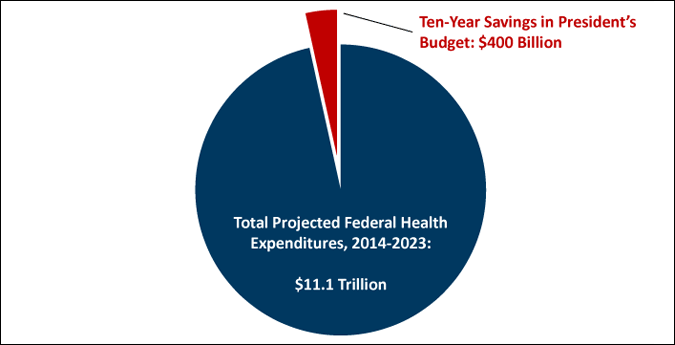
SOURCE: Data from the Office of Management and Budget, Fiscal Year 2014 Budget of the U.S. Government, April 2013. Compiled by PGPF.
NOTE: Health spending includes outlays (net of premiums) for Medicare and Medicaid in OMB's adjusted baseline and does not include reductions due to sequestration for 2014-2023.
Revenues
Under the President's budget, revenues would rise from their 2012 level of 15.8 percent of GDP to about 20.0 percent in 2023. That increase reflects both an improvement in the economy (which boosts taxable incomes) and changes in tax policy.
The budget proposes a number of tax loophole closers that the administration argues are the beginning of a national conversation about tax reform. The budget also provides for various tax deductions and credits intended to promote job creation. Some of the most significant revenue-raising proposals in the President’s budget would:
- Reduce the value of itemized deductions to 28 percent of tax liability for individuals making over $200,000 and couples making over $250,000 a year;
- Implement the "Buffet Rule," requiring that millionaires pay no less than 30 percent of their income (after charitable contributions) in taxes;
- Return the estate tax exemption and rates to 2009 levels, beginning in 2018;
- Reform the way international activities and profits of American businesses are handled under the tax code in order to reduce abuses and gaming of the system;
- Impose a "financial crisis responsibility fee" on financial firms with assets over $50 billion.
Net Interest
Federal net interest costs are projected to more than double, rising from 1.4 percent of GDP in 2012 to 2.9 percent of GDP in 2023. At that point, net interest would be the third largest category of federal spending after Social Security and Medicare.
The Long-Term Outlook
Although the President’s budget stabilizes the debt over the first ten years and takes some steps that could slow the growth of entitlement spending in the subsequent years (such as using chained CPI for Social Security’s cost-of-living adjustments), it does not stabilize the debt in the long run. Unless additional policies are enacted, PGPF projects that federal debt would still climb to 200 percent of GDP by 2056 under the President's budget.
PGPF projects long-term debt would soar under the President's budget policies after 2023
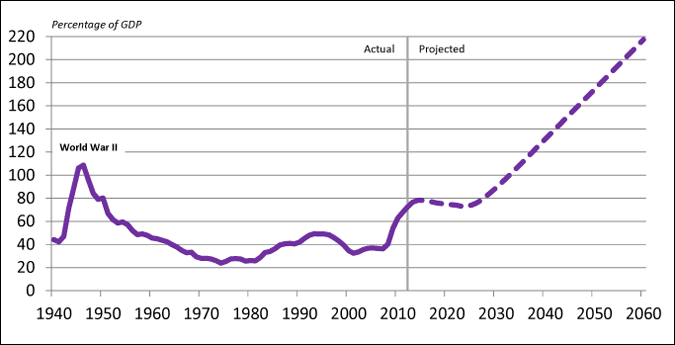
SOURCE: Peter G. Peterson Foundation calculations using data from the Office of Management and Budget, Analytical Perspectives: Fiscal Year 2014.
NOTES: The projection uses the administration's long-term assumptions for Social Security, Medicare, Medicaid, and other mandatory programs. The projection assumes that after 2023 discretionary spending rises back up to its 25-year historical average (7.9 percent of GDP) by 2028 and revenues remain at 20.0 percent of GDP (the budget's 2023 level). CBO and GAO use similar assumptions about discretionary spending and revenues in their long-term projections.
Debt at such high levels would expose the country to several, related risks:
- Loss of confidence that the United States can manage its fiscal affairs, resulting in higher interest rates and ballooning interest costs for public and private borrowers;
- Growing debt service costs that would, in the long run, crowd out the federal government's productive investments in programs such as education, research and development, and infrastructure — investments that can help our economy remain competitive and prosperous;
- Higher levels of federal borrowing that will crowd out private investment in the domestic economy, reducing real wages and harming our economy’s ability to innovate;
- Slower economic growth. Academic researchers have observed that economic growth is slower when public debt exceeds 90 percent of GDP. Many economists believe that debt below 60 percent of GDP would be prudent and allow the government room to borrow to meet urgent needs (i.e., war, recession, major national disaster) without adverse economic impacts.
The President proposes certain policies designed to slow long-term growth of mandatory spending, including some changes to the Social Security program. One change would use a new price index (known as "chained CPI") for calculating Social Security's cost-of-living adjustments. Many economists believe chained CPI is a more accurate measure of inflation than the index currently used because chained CPI accounts for how consumers alter their purchases of goods and services when prices rise. Because chained CPI would grow more slowly than the current index, it would slow the growth of benefits over time. The administration also proposes increasing Social Security benefits for people who reach age 76, which would offset some of the reduction from using chained CPI.
Impact of President’s Social Security proposals on annualbenefits for an average wage earner retiring at age 65 in 2012
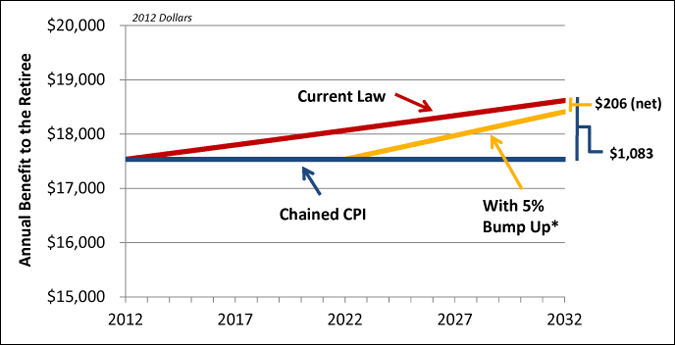
SOURCE: PGPF calculations based upon description of the proposal contained the President's FY 2014 Budget and the Social Security Administration. Compiled by PGPF.
*Beginning in 2020, a "bump up" — or increase — in benefits would be phased in between ages 76 and 85. The chart shows the benefits for the same individual from age 65 in 2012 to age 85 in 2032. Benefits are measured in 2012 dollars based on chained CPI.
Under current law, cost-of-living adjustments are projected to increase the annual benefits (in 2012 dollars) of an average wage worker retiring at age 65 in 2012 from $17,534 in 2012 to $18,617 in 2032 when the retiree would be age 85. Under the president's proposal, annual benefits for that retiree would climb to $18,411 in 2032 — about 1.1 percent (or $206) less than under current law.
Conclusion
The budgets put forth by the House, Senate, and President take steps toward addressing deficits and debt over the coming decade. However, the real threats to America’s economic future are long-term shifts reshaping our budget: structural deficits driven by rapidly rising health care spending, an aging population, and inadequate revenues that together result in massive interest costs that would burden our nation for decades. To assure our nation’s prosperity in the decades to come, we need a bipartisan plan now that protects the economic recovery in the short term, while simultaneously putting into place reforms that would be implemented later when the economy is stronger. Despite the political challenges of reaching bipartisan solutions, a number of groups have developed comprehensive, long-term reform proposals. It is time to set ideology aside and make the tough choices now to solve our fiscal challenges, in order to build confidence and lay a strong foundation for future prosperity.
1This 10-year figure includes outlays (net of premiums) for Medicare and Medicaid. It is based on OMB's adjusted baseline which assumes that the customary "doc-fix" adjustment to Medicare's Sustainable Growth Rate is made permanent. This adjustment accounts for $249 billion of the administration's 10-year projections for federal health spending.
